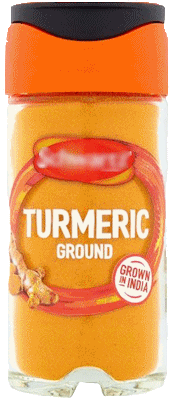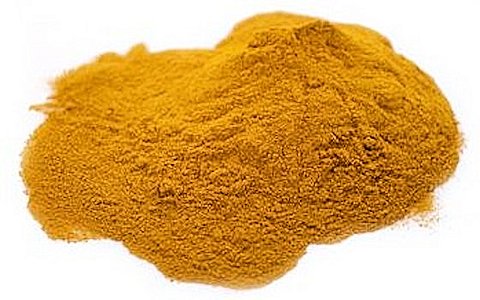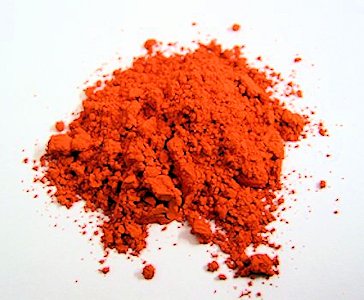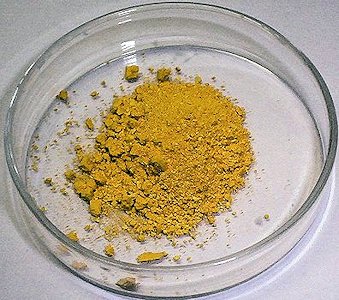![]()
Curcumin
The colour and flavour of turmeric
with controversial health claims
![]()
![]()
Molecule of the Month February 2021
Also available: JSMol version.
![]()

CurcuminThe colour and flavour of turmeric
|
 |
The name curcumin comes from the plant Curcuma longa, which itself comes from the Sanskrit kuṅkuma, referring to turmeric. Curcuma longa is a member of the ginger family (Zingiberaceae, see MOTM for March 2018) widely found in India and SE Asia. The plants forms rhisomes (enlarged, matted roots) which are prized for their source of the spice turmeric, which is used as a food additive and colouring agent (European designation E100) where it helps to protect food products from sunlight. It has a pungent, slightly bitter flavour and is a key ingredient in many savoury dishes, especially curries.

The turmeric rhizome and its orange powder spice.
[Photo: Simon A. Eugster, CC BY-SA via Wikimedia commons]
The deep orange-yellow colour of turmeric powder comes from the molecule curcumin. This pigment is so potent it is even used to dye clothes, such as Indian saris or Buddhist monks’ robes. It has also been used (together with annatto E160b) to colour cheeses, yoghurts, butter, margarine, mustard and chicken broths. However, as with most things nowadays, the yellow colour can be faked. How? And Why?Because turmeric is sold by weight, cheaper yellow-coloured chemicals can be added to a bag of turmeric to increase the profits. Unfortunately, the fake yellow compounds include chemicals such as lead oxide (red lead), lead chromate and metanil yellow, all of which are toxic. Not surprisingly, when this problem came to light in 2016 the authorities acted, and many tainted turmeric supplies imported into the US and Europe from India and Bangladesh were recalled. The situation has improved in recent years, but checks are now constantly made on all imported turmeric to look for such dangerous adulteration. |
 The robes of Buddhist monks are often dyed with orange curcumin. [Photo: 松岡明芳, CC BY via Wikimedia Commons] |
 |
 |
 |
| Curcumin powder [Photo: BroviPL, public domain via Wikimedia Commons] |
‘Red’ lead oxide [Photo: BXXXD, CC BY-SA via Wikimedia Commons] |
Lead chromate [Photo: FK1954, CC0 via Wikimedia Commons] |
And in chemistry, turmeric can even be used as an acidity indicator. How?Using so-called 'turmeric paper' – which is paper steeped in a tincture of turmeric and allowed to dry. It is used as an indicator of pH because the paper is yellow in acidic and neutral solutions with pH < 7.4, but turns reddish-brown in alkaline solutions with pH > 7.4. |
 Turmeric paper used as a pH indicator. [Photo: Turmeric.com] |
There are a number of active ingredients in turmeric, the most important of which is curcumin. But there are other variants, including demethoxycurcumin and bisdemethoxycurcumin.
 |
| Curcumin Replace one methoxy group (shown in red) with H to make demethoxycurcumin, and replace both methoxy groups to make bisdemethoxycurcumin. |
I’ve heard that turmeric is medically good for you?Well, if you go any health-food shop you’ll be able to buy lots of turmeric supplements that claim to treat almost anything: anti-ageing, anti-cancer, skin care, fertility, erectile dysfunction, weight loss, and even prevention of baldness! However, most medical experts are far more cautious, and say there is no high-quality clinical evidence (yet) for using turmeric or curcumin, to treat any disease. To date, there have been 350 completed clinical trials looking at possible health benefits of curcumin, and there are currently hundreds more taking place looking at curcumin for range of different ailments. So why are the results of these trials often so inconclusive?It’s to do with the structure of curcumin. It contains an α-β-unsaturated ketone, which makes it highly reactive, especially towards proteins. However, this reactivity also means it’s less selective – it reacts with many proteins indiscriminately. A molecule like this is often called ‘promiscuous’ because it’s not fussy about what other molecules it interacts with! |
 |
Sounds racy! But why does that matter?Many clinical drug-screening tests work by reacting the drug with a protein related to the disease in question, and then testing that protein for changes in function. If the function of the protein has changed, this means the drug molecule has bonded to it, and the trial is considered a success – the drug is then moved on to the next stage of testing, usually in a live animal. But curcumin bonds to nearly everything, and so gives a positive result in a great many tests, no matter what the protein, or the disease. That sounds great! It cures everything…!Not so fast! Just because a drug appears to work in the lab, doesn’t mean it works in living creatures. In fact, curcumin is notorious for being a PAIN (pan assay interference) compound – one which very often gives false positive results in lab screening tests, only for it to fail completely in subsequent animal experiments. |
 |
In order to be viable, first a drug needs to be stable in the body for long enough to reach the affected organ or cells and do its job. Unfortunately, under the conditions present in your bloodstream (body temperature and roughly neutral pH), curcumin breaks down in only about 20 minutes. This is not really long enough for it to have much impact on any diseased cells or organs. Under acidic conditions (e.g. like those in our stomachs), its stability is increased somewhat, but it’s now much less soluble. Thus, most of the curcumin ingested by mouth (e.g. as pills) cannot pass from the stomach into the bloodstream, and the vast majority is then simply excreted. A possible way around this insolubility problem is to give very high doses of curcumin, but this can cause side-effects such as kidney injury. Another route is to chemically alter the structure of curcumin to make it more soluble – and a few labs are currently working on this.
Due to the promiscuity of curcumin in lab tests, but its lack of stability and solubility in the body, scientists often initially get very excited about curcumin passing the lab tests, saying ‘it might be the new wonder cure’ for a certain medical condition, only to have their hopes dashed a few years later when the clinical trial results show it doesn’t work in real patients. Curcumin is such a PAIN, that this sequence of initial success followed by subsequent clinical failure has been repeated many of times when screening curcumin against dozens of different medical conditions. But, as usual, this doesn’t stop the health-food shops making extravagant claims based on the initial promising lab results, while conveniently forgetting the subsequent negative clinical results.
 So turmeric isn’t good for you after all?
So turmeric isn’t good for you after all?That can’t be said definitively. We can say that its main component, curcumin, doesn’t (yet) appear to have any proven health benefits. But turmeric contains over 300 other biochemical compounds, including dimethoxy- and bisdemethoxycurcumin (see structures earlier), as well as resveratrol, polyphenols, vitamins (B1, B3, C and E), and minerals (iron, calcium, phosphorus), many of which have health benefits, either individually or in synergy with other components. And a 2023 study from the New York Institute of Technology College of Osteopathic Medicine suggested that when curcumin is used alongside chemotherapy, ovarian cancer patients may respond better to treatments.
By all means add turmeric to foods and curries for its flavour. But if someone claims it has 'proven' health benefits, it’s best to take that with a pinch of salt!
![]()
Wikipedia:
![]()
![]() Back to Molecule of the Month page. [DOI:10.6084/m9.figshare.11926431]
Back to Molecule of the Month page. [DOI:10.6084/m9.figshare.11926431]